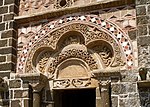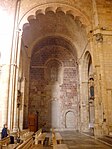Multifoil arch

Amultifoil arch(or polyfoil arch), also known as acusped arch,[1][2]polylobed arch,[3][4]orscalloped arch,[5]is anarchcharacterized by multiple circular arcs or leaf shapes (calledfoils,lobes, or cusps) that are cut into its interior profile or intrados.[2][1][6][7]The termfoilcomes from theold Frenchword for "leaf." A specific number of foils is indicated by a prefix:trefoil(three),quatrefoil(four), cinquefoil (five), sexfoil (six), octofoil (eight). The term multifoil or scalloped is specifically used for arches with more than five foils.[8][9][10]The multifoil arch is characteristic ofIslamic artandarchitecture;particularly in theMoorish architectureofal-Andalus(Iberian Peninsula) andNorth Africaand inMughal architectureof theIndian subcontinent.[11]Variants of the multifoil arch, such as thetrefoil arch,are also common in other architectural traditions such asGothic architecture.[2]: 132
Origins
[edit]The first multifoil arches were developed by theUmayyadsand can be found in a small mosque atQasr al-Hallabat,one of theUmayyad Desert Castles,in present-dayJordan.[12][13]The architects of this structure experimented with both hollow/concave lobes and protruding/convex lobes in therelieving archesabove the doors.[14]: 513–514 Multifoil arches also appear early on as decorative niches in theQasr al-'AshiqinSamarra,present-dayIraq,and in theMosque of Ibn TuluninCairo,Egypt,both of which were built underAbbasid(andTulunid) rule in the 9th century.[1][15][16]: 87 These examples have been used to support the hypothesis that multifoil arches originated in theMiddle Easternregions of the Islamic world, althoughRichard Ettinghausen,Oleg Grabarand Marilyn Jenkins-Madina have called this hypothesis into question.[16]: 87–89 [14]: 513
Other early examples of multifoil arches are found in theGreat Mosque of Cordobainal-Andalus(present-daySpain), in particular the arches of themaqsuraarea added to the mosque in the 10th century byal-Hakam II.[17]: 232–234 Ettinghausen, Grabar, and Jenkins-Madina argue that the form of these arches probably developed locally in al-Andalus, noting that in Cordoba they occurred as structural elements while in the eastern Islamic world they occurred mostly as decorative elements.[16]: 87–89 Another scholar, Ignacio Arce, notes that Ettinghausen and Grabar did not take into account the earlier occurrences at the Qasr al-Hallabat mosque, where polylobed arches are used as structural elements.[14]: 513–514 Jonathan Bloom also argues that the intersecting cusped arches of the Great Mosque of Cordoba were a local development, likely the result of a deliberate elaboration from the older two-tiered round arches that were part of the mosque since its initial foundation in 785.[18]: 72
-
Polylobed arch (with convex or protruding lobes) atQasr al-Hallabat,Jordan(7th–8th century)
-
Intersecting multifoil arches in theGreat Mosque(present-day cathedral) ofCordoba,Spain (10th century)
Later developments
[edit]North Africa and al-Andalus
[edit]The typical multifoil arches that appear in later buildings of Al-Andalus and North Africa also have precedents inFatimid architectureinIfriqiyaand Egypt, for example atBab Zuweila(dated to 1091).Georges Marçaisargued that both the Great Mosque of Cordoba and Fatimid architecture in Ifriqiya were probably the most relevant precedents which led to the adoption and development of multifoil arches in the western regions of the Islamic world.[17]: 232–234 Multifoil arches appear prominently in the 11th-centuryAljaferia palaceof theTaifasperiod in al-Andalus. In theAlmoravidandAlmohadperiods (11th–13th centuries), this type of arch was further refined for decorative functions whilehorseshoe archescontinued to be standard elsewhere.[17]: 232–234 They appear, for example, in theGreat Mosque of Tlemcen(in present-dayAlgeria) and theMosque of Tinmal(present-day Morocco).[17]: 232 The motif of intersecting multifoil arches also gave rise to thesebkamotif which is frequently employed in the art and architecture of the region.[17]: 257–258 In Egypt, the cusped trefoil or trilobed arch became a characteristic decorative feature ofportalsin late Fatimid architecture andMamluk architecture(from approximately the 12th to 16th centuries).[19]: 191 [20]: 89
-
Interlacing multifoil arches at theAlcazaba of Malagain Spain (11th century)
-
Multifoil arch in front of themihrabin theGreat Mosque of Tlemcen(11th-12th centuries)
-
Blindinterlacing multifoil arches on theAlmohadminaret of theKutubiyya MosqueinMarrakesh,Morocco(12th century)
-
Multifoil arches in theMudéjarPatio de las Doncellasat theAlcazar of Sevillein Spain (14th century)
-
Trilobed (trefoil) arch in the entrance of theMamluk-eraKhanqah-Mausoleum of Sultan Barsbayin Cairo (completed in 1432)
Indian subcontinent
[edit]The cusped arch is attested inHindu temple architecturesuch as the trilobed or trefoil arches of theMartand Temple(8th century) and the temple of Pandrethan (10th century), both inKashmir,[22]as well as at the temple ofMalot(10th century) in northernPunjab.[23]: 58 The example at the Martand Temple is made with acorbelledstone construction.[24]This use of a trefoil arch, typically inside a triangularpedimenton the façade of temples, was a characteristic feature of Hindu architecture in Kashmir and thewestern Himalayanregion during this time.[25][24][26]Some of the earliest trefoil-arched entrances in this tradition are attested in temples atBilotandMari-Indus,dated byMichael W. Meisterto the late 6th or early 7th century and the 8th century, respectively.[23]: 31, 36–37 Over the 9th and 10th centuries this style evolved further and sometimes incorporated five-lobed (or cinquefoil) arches, as exemplified in theAmb templesdated to this period.[23]: 31 The most important contribution ofIndo-Islamic architectureto this region was the introduction the"true" archduring theDelhi Sultanateperiod,[a]which progressively replaced thetrabeateor corbel arch.[22][29]After this, multifoil arches later became a characteristic feature ofMughal architectureduring the 17th century,[30][31][32]particularly during the reign ofShah Jahan(r. 1628–1658).[33][34]It was also characteristic ofRajput architecture,which developed in close relation with Mughal architecture during theMughal era.[35][31]
-
RuinsofMartand Sun Temple,India with a multifoil arched gateway, finished between 625-885 A.D under theKarkota empire.[36]
-
Multifoil arch atAmb temple complex,Pakistan. An example from theHindu Shahisperiod, dated between 800-950 AD.[37]
-
Multifoil arches withjaliatAmber fort,India. An example ofRajput architecture,commissioned in 1592.[40]
-
Multifoil arches insideLotus Mahal,Hampi,India. An example ofVijayanagara architecturefrom the 16th century.[41]
-
Multifoil arches withparchinkariinDiwan-i-Am,Red Fort,India. An example of Mughal architecture, built between 1631-40.[42]
-
Multifoil arch withmuralon lotus gate,City Palace, Jaipur,India. An example ofRajput architecture,built between 1727-32.[43]
Christian Europe
[edit]In the architecture of Christian Europe, multifoil arches appear occasionally inRomanesque architecture,with some early examples inFrancesuch as thechapel of Saint-Michel-d’AiguilheinLe Puy-en-Velay,France (10th–11th century) and theAbbey of Cluny(circa 1100).[1][46]: 272 In the Christian territories of the Iberian Peninsula (present-day Spain), the earliest examples are from the early 12th century and found in theCollegiate Church of San IsidoroinLéonand theCathedral of Santiago de Compostela.[46]: 272 These early Iberian examples were highly similar to the multifoil arches of contemporary Islamic/Moorish architecture in al-Andalus and were probably directly appropriated from the latter.[47]: 105–107 [46]: 272 Scholars Francine Giese and Sarah Keller argue that this initial appropriation from Muslim architecture was likely intended to express a sense of triumph and superiority over Islamic al-Andalus at the time, but that over the course of the 12th century the motif becameacculturatedto Romanesque art and then developed independently from al-Andalus in both Christian Iberia and France.[46]: 272 As a result, multifoil arches became more common and developed multiple variations in the Romanesque architecture of these regions during the later 12th century.[47]: 105–107 [46]: 272 InToledo,after its conquest byCastilein 1085, the new churches andsynagogueswhich were built in the 12th century and after were designed in aMudéjar stylethat frequently incorporated polylobed arches as part of its visual repertoire.[46]: 273 TheCathedral of Toledo,whose construction began in the 13th century, was built primarily in a Gothic style but also incorporates polylobed arches (most notably in thetriforiumof theambulatory), suggesting that this motif had by then become thoroughly assimilated to local Christian architecture.[46]Multifoil arches, particularly trefoil arches, became common in Gothic architecture for portals and decoration throughout Europe.[2]Cusped forms (not necessarily as arches) were also common to form the motifs used in Gothictracery.[1]
-
Blind polylobed arch above the door of theRomanesquechapel ofSaint-Michel-d’AiguilheinLe Puy-en-Velay,France (10th–11th century)
-
Multifoil arch in theChurch of San IsidoroinLéon,Spain (early 13th century)
-
Multifoil arch decoration on theMudéjarbell tower of theChurch of Santo ToméinToledo,Spain (14th century)
-
Decorated multifoil/trefoil portal in theCapelas Imperfeitasof theBatalha Monastery,Portugal(circa 1435)
See also
[edit]Notes
[edit]References
[edit]- ^abcde"cusp | architecture | Britannica".britannica.Retrieved2021-11-19.
- ^abcdHourihane, Colum (2012).The Grove Encyclopedia of Medieval Art and Architecture.Vol. 2. Oxford University Press.ISBN978-0-19-539536-5.
- ^"Qantara - Fragment of wood ornamented with arches".qantara-med.org.Retrieved2020-09-11.
- ^Llorente, Margarita Sánchez."Arch".Discover Islamic Art - Virtual Museum.Retrieved2020-09-11.
- ^Ragette, Friedrich (2003).Traditional Domestic Architecture of the Arab Region.Edition Axel Menges. p. 37.ISBN978-3-932565-30-4.
- ^"Cusped Arches".National Geographic Society.2012-09-14. Archived fromthe originalon 2021-11-19.Retrieved2021-11-19.
- ^Curl, James Stevens; Wilson, Susan (2015).The Oxford Dictionary of Architecture.Oxford University Press.ISBN978-0-19-967498-5.
- ^"Definition of MULTIFOIL".merriam-webster.Retrieved2022-05-16.
- ^"Multifoil".buffaloah.Retrieved2022-05-16.
- ^Davies, Nikolas; Jokiniemi, Erkki (2012-05-04).Architect's Illustrated Pocket Dictionary.Routledge.ISBN978-1-136-44406-7.
- ^Lookuparchitecture: Moorish archesArchived2012-04-04 at theWayback Machine.Retrieved 21 November 2011
- ^Alexander Sarantis, Enrico Zanini, Luke Lavan. (2008). Technology in Transition A.D. 300-650, Brill, p. 513.
- ^Diana Darke. (2020). Stealing from the Saracens: How Islamic Architecture Shaped Europe, Hurst, p. 166.
- ^abcArce, Ignacio (2008)."Umayyad Building Techniques and the Merging of Roman-Byzantine and Partho-Sassanian Traditions: Continuity and Change".In Lavan, Luke; Zanini, Enrico; Sarantis, Alexander (eds.).Technology in Transition A.D. 300-650.Brill. pp. 491–538.ISBN978-90-474-3304-0.
- ^Petersen, Andrew (1996). "arch".Dictionary of Islamic architecture.Routledge. pp. 24–25.ISBN9781134613663.
- ^abcEttinghausen, Richard; Grabar, Oleg; Jenkins-Madina, Marilyn (2001).Islamic Art and Architecture: 650–1250(2nd ed.). Yale University Press.ISBN9780300088670.
- ^abcdeMarçais, Georges (1954).L'architecture musulmane d'Occident.Paris: Arts et métiers graphiques.
- ^Bloom, Jonathan M. (2020).Architecture of the Islamic West: North Africa and the Iberian Peninsula, 700-1800.Yale University Press.ISBN9780300218701.
- ^Graves, Margaret S. (2018-07-31).Arts of Allusion: Object, Ornament, and Architecture in Medieval Islam.Oxford University Press.ISBN978-0-19-069592-7.
- ^Behrens-Abouseif, Doris (2007).Cairo of the Mamluks: A History of Architecture and its Culture.The American University in Cairo Press.ISBN9789774160776.
- ^"Qantara - Gates of Bāb al-Nasr, Bāb al-Futūh, and Bāb al-Zuwayla".qantara-med.org.Retrieved2021-11-19.
- ^abManchanda, Bindu (2006).Forts & Palaces of India: Sentinels of History.Roli Books Private Limited.ISBN978-81-7436-381-7.
- ^abcMeister, Michael W. (2010).Temples of the Indus: Studies in the Hindu Architecture of Ancient Pakistan.Brill.ISBN978-90-04-19011-5.
- ^abMichell, George (1988).The Hindu Temple: An Introduction to Its Meaning and Forms.University of Chicago Press. p. 127.ISBN978-0-226-53230-1.
- ^Brown, Percy (1959).Indian Architecture (Buddhist and Hindu Period).Mumbai: D.B. Taraporevala. p. 157.ISBN978-1-4474-9857-5.
- ^Handa, Om Chanda; Hāṇḍā, Omacanda (2001).Temple Architecture of the Western Himalaya: Wooden Temples.Indus Publishing. p. 102.ISBN978-81-7387-115-3.
- ^Ray, Aniruddha (2019).The Sultanate of Delhi (1206-1526): Polity, Economy, Society and Culture.Routledge. pp. 385–386.ISBN978-1-000-00729-9.
- ^Loofs-Wissowa, Helmut (1986)."The True and the Corbel Arch in Mainland Southeast Asian Monumental Architecture".In Marr, David G.; Milner, Anthony Crothers (eds.).Southeast Asia in the 9th to 14th Centuries.Institute of Southeast Asian Studies. p. 246.ISBN978-9971-988-39-5.
- ^Liddle, Swapna(2019). "The Qutub Minar and the village of Mehrauli: Multiple meanings in monuments". In Ray, Himanshu Prabha (ed.).Decolonising Heritage in South Asia: The Global, the National and the Transnational.Taylor & Francis. pp. 158, 161.ISBN978-0-429-80285-0.
- ^M. Bloom, Jonathan; S. Blair, Sheila, eds. (2009). "Architecture; VII. c. 1500–c. 1900; D. India".The Grove Encyclopedia of Islamic Art and Architecture.Oxford University Press.ISBN9780195309911.
- ^abDadlani, Chanchal; Sharma, Yuthika (2017)."Beyond the Taj Mahal: Late Mughal Visual Culture".In Flood, Finbarr Barry; Necipoğlu, Gülru (eds.).A Companion to Islamic Art and Architecture.Wiley Blackwell. p. 1062.ISBN9781119068662.
- ^Nath, R. (2006). "Monuments: Mughal". In Wolpert, Stanley A. (ed.).Encyclopedia of India: Vol. 3.Thomson Gale. pp. 156–165.ISBN978-0-684-31352-8.
- ^Parihar, Subhash (1999).Some Aspects of Indo-Islamic Architecture.Abhinav Publications. p. 92.ISBN978-81-7017-381-6.
- ^Chaitanya, Krishna (1987).Arts of India.Abhinav Publications.ISBN978-81-7017-209-3.
- ^Dadlani, Chanchal (2016)."Innovation, Appropriation, and Representation: Mughal Architectural Ornament in the Eighteenth Century".In Necipoğlu, Gülru; Payne, Alina (eds.).Histories of Ornament: From Global to Local.Princeton University Press. p. 185.ISBN978-0-691-16728-2.
- ^Lone, Shabir Ahmad (2022-05-26)."Art and Architecture of Ancient Kashmir During Karkota Dynasty with Special Reference to Lalitaditya Muktapida (724-761 A.D)".Journal of Psychology and Political Science.2(3): 11–20.ISSN2799-1024.
- ^Talbot, W. S. (April 1903)."Art. XII.—An Ancient Hindu Temple in the Punjāb".Journal of the Royal Asiatic Society.35(2): 335–338.doi:10.1017/S0035869X00030379.ISSN2051-2066.S2CID164193218.
- ^Zeeshan, Mahwish (2015)."Masonry art: Preservation of archeological sites in Chakwal".The Explorer Islamabad: Journal of Social Sciences.1(7): 251–254.
- ^"Incredible India | Agra Fort".incredibleindia.org.Retrieved2022-11-02.
- ^"Incredible India | Amber Fort".incredibleindia.org.Retrieved2022-11-02.
- ^World, Veena (2021-04-01)."Lotus Mahal: An Architecture Highlight of Hampi | Veena World".Veena World Blog.Retrieved2022-11-03.
- ^Wright, Colin."[Interior of the Diwan-i-Am, Fort, Agra.]".bl.uk.Retrieved2022-11-02.
- ^Pote, Shareen (2013-11-02)."10 Interesting Facts About City Palace Jaipur".Remote Traveler.Retrieved2022-11-03.
- ^Manchanda, Bindu (2001).Jaisalmer: The City of Golden Sands and Strange Spirits.HarperCollins Publishers India. p. 81.ISBN978-81-7223-434-8.
- ^"Incredible India | Nathmal Ki Haveli".incredibleindia.org.Retrieved2022-11-02.
- ^abcdefgGiese, Francine; Keller, Sarah (2021)."The Limits of Otherness: Decoding the Entangled Heritage of Medieval Iberia".In Giese, Francine (ed.).Mudejarismo and Moorish Revival in Europe: Cultural Negotiations and Artistic Translations in the Middle Ages and 19th-century Historicism.Brill. pp. 269–279.ISBN978-90-04-44858-2.
- ^abMartin, Therese (2006).Queen as King: Politics and Architectural Propaganda in Twelfth-Century Spain.Brill.ISBN978-90-474-1851-1.
External links
[edit]![]() Media related toMultifoil archesat Wikimedia Commons
Media related toMultifoil archesat Wikimedia Commons

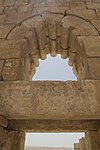
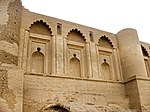


![Blind polylobed arch at the Fatimid gate of Bab Zuweila, Cairo, Egypt (1087–1092)[21]](https://upload.wikimedia.org/wikipedia/commons/thumb/a/a9/Bab_Zuweila_2019-11-02q.JPG/103px-Bab_Zuweila_2019-11-02q.JPG)


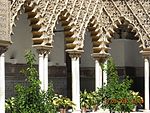

![Ruins of Martand Sun Temple, India with a multifoil arched gateway, finished between 625-885 A.D under the Karkota empire.[36]](https://upload.wikimedia.org/wikipedia/commons/thumb/8/8a/Martand_Sun_Temple_Central_shrine_%286134368088%29.jpg/150px-Martand_Sun_Temple_Central_shrine_%286134368088%29.jpg)

![Trefoil arches crowning blind niches on Malot Temple, Pakistan, built around 980 AD.[38]](https://upload.wikimedia.org/wikipedia/commons/thumb/5/51/Malot_temple_9.jpg/112px-Malot_temple_9.jpg)


![Multifoil arches inside Lotus Mahal, Hampi, India. An example of Vijayanagara architecture from the 16th century.[41]](https://upload.wikimedia.org/wikipedia/commons/thumb/b/b8/Lotus_Mahal_%2820010032278%29.jpg/150px-Lotus_Mahal_%2820010032278%29.jpg)

![Multifoil arch with mural on lotus gate, City Palace, Jaipur, India. An example of Rajput architecture, built between 1727-32.[43]](https://upload.wikimedia.org/wikipedia/commons/thumb/e/e9/SE_Gate%2C_Pritam_Niwas_Chowk%2C_City_Palace_Jaipur.jpg/127px-SE_Gate%2C_Pritam_Niwas_Chowk%2C_City_Palace_Jaipur.jpg)

